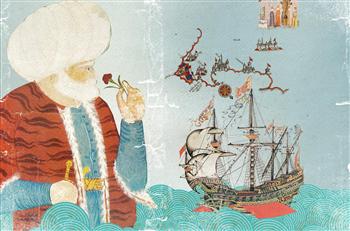The exploits of the Ottomans on land are well-known, especially during the empire’s golden age. The Turks, however, also developed profound sea power during the 16th century, allowing it to take most of the eastern Mediterranean and harry the west.

Kemal, Hayreddin, Turgut, Piyale, Uluç, Kılıç Ali, Piri – the outstanding captains and admirals of the Ottoman fleet in the 16th century; there were more, but these are the ones whose names are still known today for their exploits and successes and the mosques or monuments they left behind.
What these men have in common is that they lived and sailed in a 75-year period that marked the height of the Ottoman classical era. Some bore the honorific title of “reis” or captain; others bore the title “kapudan-i derya” or admiral of the sea. Barbarossa Hayreddin not only became a paşa, but he was the first naval commander to be given a seat on the imperial divan or council. There was no naval academy. These men learned their trade at sea as corsairs or privateers.
We first read about Ottoman Turkish exploits on the sea in the 14th century after they had carved out a small principality or beylik that included the western coast of Anatolia by 1347. It didn’t take the Ottomans long to realize that they needed ships to defend their new possessions so they set about building their own at Edincik, Gemlik, Karamursel and İzmit. The ships built there were modeled on the Venetian galley – a long, sleek, highly maneuverable ship that relied on oars for propulsion. These galleys contributed to the success of the privateers that worked for the Ottomans and served as the mainstay of the Ottoman navy until the 17th century.
During the latter part of the 15th century, the Ottomans began to build a fleet in earnest. Several Ottoman galleys had taken part in the conquest of Constantinople in 1453. Although the sultan’s navy had 320 vessels, most of them were transport and supply ships. More galleys took part in the attack on Otranto in Italy in 1480 as part of Fatih Sultan Mehmed’s plan to conquer Rome. The Turks were able to hold it for 13 months because they could be resupplied by sea. (Probably the most famous corsair, Barbarossa Hayreddin, recaptured the city in 1537 but couldn’t hold on to it.) The fleet was also used during the first siege of Rhodes in 1480 and was also sent into the Black Sea (1484) where it eventually turned that body of water into an Ottoman lake in the next century.
Serving as a shield
The real expansion of the fleet occurred when it was ordered to accompany Sultan Selim I as he marched with his army in 1517 to conquer Syria and then Egypt. The Ottoman ships for all intents and purposes served as a shield for the soldiers but must have also helped with supplies and communications. The fall of Rhodes in 1522 was the beginning of the Ottoman conquest of the eastern Mediterranean. The conquest of Cyprus in 1571 essentially completed it. With the conquest of Egypt and the accession of the cities of Mecca and Medina, the Ottomans continued to advance into the Red Sea and the Indian Ocean. The acquisition of Yemen in 1517 and then Basra in 1534 allowed them to enter the Persian Gulf; however, they had to continually confront the Portuguese who had a strong hold on the area and were bent on defending their lucrative trade with India and further east.
Ottoman expansion into the western Mediterranean was somewhat different and where European countries were concerned, seems to have been more about raiding and pillaging rather than outright conquest. This is borne out by the detailed list of Ottoman conquests, sieges and landings provided by Wikipedia. By far the most entries are landings at towns and villages along the Italian and Spanish coasts. The goal of the Ottomans was apparently more to protect the Muslim territories in North Africa than gain European territory. With that in mind, they took Tripoli in 1551 and Tunis in 1574, at times defeating a Spanish or Spanish-Italian fleet and at times being defeated likewise at Lepanto in 1571.
Ottoman naval shipyards
Ottoman shipbuilding, as mentioned above, started in the 14th century although it was not given much emphasis until after the conquest of Constantinople when Fatih Sultan Mehmed’s vision of the empire’s future included reaching as far as Rome. The Byzantines had maintained a shipyard on the Golden Horn prior to the capture of the city but the Ottomans continued afterwards to use their naval base at Gallipoli which had been founded by Sultan Bayezid II in 1390 as their main location. They didn’t set up their own arsenal in the Golden Horn until the reign of Sultan Selim I (r. 1512-1520) in the location where it is today.
The arsenal was sufficiently large that nearly 100 ships could be under construction at the same time. There were storage depots and workshops, accommodations for the fleet admiral and even a prison where the slaves who worked on the boats were kept at night. The facility suffered a destructive fire in 1539 and was rebuilt in 1547 and surrounded by a high wall for protection. According to the “Osmanli Donanmasinin Seyir Defteri” (The Logbook of the Ottoman Navy), the arsenal reached its peak activity following the defeat of the Ottoman fleet at Lepanto. The then-grand vizier ordered that 200 ships be built within a five-month period. Whether or not that many were actually completed or not is unknown but certainly enough were constructed to shock the Europeans who had been congratulating themselves on the fatal blow they’d dealt the Ottomans. Under normal circumstances, however, the arsenal workers might produce 45-50 ships. “The galley … was the archetypal warship of the Ottoman navy in the 16th and most of the 17th century. The galley measures 40 to 42 meters in length, 5.5 meters in width and has a draught of two meters… It requires a crew of 300 to 320 men, including some 20 seamen, a varying number of soldiers, and most importantly, 220 to 250 oarsmen,” according to “The Longbook.”
There were larger and smaller variations of the galley, including a rather larger one, adopted from a similar ship of the Venetians, called a “mavna,” or galleass, which was equipped with cannon and had a crew of almost 600 men.
But the outstanding naval men of the 16th century Ottoman fleet learned their craft on the traditional galley by serving on board as apprentices until they were deemed good enough to have their own vessels. And although the waters of the Mediterranean could be dangerous, they could be highly profitable, too.
HDN















